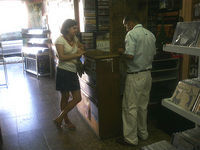Message from Brazil4 - National Samba Day
Tagged with: Samba Bahia Brazil Salvador Pelourinho Mercado Cultural Sinho Ary Barroso Na Baixa do Sapateiro Luis Monteiro de Costa Black Style Chuva de Perereca Tessa Burwood WorldMusic.co.uk world music pagode
December 2nd was O Dia Nacional do Samba (National Samba Day). I missed it, having just arrived here, and wanted to find out more about it, so I've been doing some research, and asking around. Its origins and motives make an interesting comparison to the Mercado Cultural music festival.
Mercado Cultural is a really interesting concept for a festival – the culmination of a year-round caravan of musicians, producers, managers and cultural representatives from various genres, who travel throughout Brazil and abroad, to perform, discuss and disseminate their work. The aim is to explore the challenges of maintaining a truly fruitful intercultural dialogue. Beyond race and language, this caravan also unites people across the most obvious, yet nuanced and difficult barrier we face today – the socioeconomic divide.
Here in Brazil, this divide is much more difficult to cross, although in recent years the expanding middle class has begun to link the two uncomfortably coexisting worlds – the very rich minority, and the penniless majority. Sharing music is a fascinating, at times problematic, but ultimately positive method of bringing these worlds together. Brazil is, after all, synonymous with samba, and samba evolved from the work songs and spirituals sung by African slaves in Bahia. As I briefly touched on in the previous article, it was the influx of poor Bahian workers into Rio during the late 19th – early 20th century that first brought samba to the ears of well off, white Brazilians.
Sinhô and his contemporaries became the intermediaries between these two cultures, because they were tacitly accepted by both worlds. That said, a good measure of prejudice has always tempered this upper class fascination with samba. Sinhô's derogatory comments on Bahian people, and his willingness to appropriate their music while taking the credit, polarise the dividing line between Bahia and Rio, rich and poor, black and white, through cold rejection.
But there is another, more subtle and ultimately sinister way to exclude a culture, and that is to exoticise and objectify it. While Sinhô stole from Bahian samba singers and claimed their songs for himself, while openly criticising what he saw as an uncultured and backward Bahian race, his contemporary and neighbour Ary Barroso described a scene of sexual longing between a white woman from Rio and a dark skinned man from Salvador, in a city he had never seen. "Na Baixa do Sapateiro" is the story of a woman looking for love in Salvador. She meets a dark skinned Bahian man lazing in the shade in Baixa do Sapateiro, and tries unsuccessfully to seduce him.
Now a busy shopping district between Pelourinho, Saude and Barroquinha, Baixa do Sapateiro was, at one time, the home of an Italian shoe manufacturer – hence the name ('sapateiro' means shoemaker). It's fame spread throughout Brazil when three cinemas ran there simultaneously, and Ary Barroso (who wrote music for film) presumably identified with the area, despite not setting foot in Bahia, let alone Salvador, until years later. Here's a translation of the samba he wrote:
Bahia, happy dark skinned land,
I miss you like mad!
Our Lord of Bomfim,
Find me another man with dark skin
Just the same, just for me.
In Baixa do Sapateiro
I came across one day,
A lazy dark skinned man from Bahia
I asked him for a kiss, he refused
An embrace, and he just smiled
I asked for his hand
He would not give it
And ran away...
Bahia, happy dark skinned land,
I miss you like mad!
Our Lord of Bomfim,
Find me another man with dark skin
Just the same, just for me.
In the 1940s, this samba's fame spread to the ears of a local councillor in Salvador, whose name was Luis Monteiro da Costa. Inspired by the song – or perhaps frustrated, who knows - he founded O Dia Nacional do Samba (National Samba Day.) This day falls on December 2nd, and was originally only celebrated in Salvador – in recognition of samba's origin. More recently, it became a national holiday, and is now celebrated across Brazil.
Meanwhile, 'Na Baixa do Sapateiro' entered decisively into the Brazilian canon, interpreted by famous singers like Elis Regina and João Gilberto. It is emblematic of a vision of Bahia repeated in Brazilian popular music – that Bahian people are docile, lazy and sexually available. Although in the case of this samba, the Bahian man refused such advances, there's something sinister in the air here in Salvador. Sex tourism is rife here, and male prostitution is particularly noticable.
I walk through Terreiro de Jesus in Pelourinho, past the men practicing capoeira in the square and calling out to female tourists. In Praça da Sé, a leather skinned Italian woman drags a local mixed race guy by the hand into the entrance of a hotel. In Baixa do Sapateiro, I hear music blasting from speakers on a pirate CD salesman's truck: a song from Bahian pagode star Black Style's latest album (eponymous), called "Chuva de Perereca" (‘It’s Raining P**sy’). On the front cover of the CD, Black Style sings to a stadium packed out with screaming female fans. I feel quite embarrassed – more of a prude than I thought :)
Tessa Burwood for WorldMusic.co.uk
Message from Brazil 1 - Vinyl Pelourinho
Tagged with: Brazil Pelourinho Bahia Salvador Planet Music Ajuda 39 MPB musica sertaneja forro samba bossa nova Caetano Veloso Ce Eterna Dimensao Zeca Pagodinho Tessa Burwood WorldMusic.co.uk World Music
This is the first report from our own correspondent Tessa Burwood who's currently out in Brazil. Tess will be sending in her reports as to what she sees, muses and gets up to over the next three weeks. In this one she's arrived in the city of Salvador in Bahia, Northern Brazil (traditionally cited as the most African of all Brazilian states) and set up base in the old slave area of Pelourinho, one of the most culturally vibrant areas of the city:
"Who said music shops were dead?"
"Who said music shops were dead? Planet Music and Ajuda 39 in Pelourinho are in a healthy state.
Avelar began working at Planet Music as a kid, because he spent so much time in there flicking through records that the shop assistant told him to go speak to the boss:
"From shop rat to boss via passion for music - I love my job!"
There's an exhaustive collection of MPB, musica sertaneja, forro, samba, everything you can think of when it comes to the music loving public that pass through Pelourinho. Apparently, the French always ask for bossa nova,
"Just as elegant as they like to think they are," says Avelar with a wry grin.
"German tourists don't like Brazilian music at all. They only buy CDs as presents for the folk back home, hardly even look at the covers or ask any questions. What can I say? They just don't dig us!"
Avelar's favourites include Pink Floyd and Kraftwerk, he knows all the dates of birth of everyone in the former, and listened to the latter when, during the Cold War the airwaves were flooded with American music, and anything deemed transgressive was contraband.
He was pleased to tell me that Caetano Veloso recently made up 500 copies of his seminal album "Ce" on vinyl for his closest 500 friends. Sony have opened a vinyl production unit down south, apparently.....
Round the corner at Ajuda 39, it's a vinyl purist's heaven - as you can see from the photos. Tekko works behind the counter by day and plays samba by night in a band called Eterna Dimensao. They're playing on Sunday in Rio Vermelho, I'm going to check them out. I asked him what was his favourite record in the whole shop, and it seemed he'd been mooning over it all afternoon! Zeca Pagodinho :)
Tomorrow, percussion class at 2pm, who knows where my rhythm's at?! "
Tessa Burwood for WorldMusic.co.uk
[There will be more from Tessa as she moves around Brazil in the next three weeks, including a trip to the remote settlement of São Braz in Bahia state to check out a village whose entire culture has been officially protected by the United Nations. Stay tuned.]
Womex 2010 - Editor's Highlights (part one)
Tagged with: worldmusic.co.uk world music Womex Copenhagen Denmark Koncerthuset Antonio Zambujo Papa Wemba LaBrass Banda Tremor ZZK Las Migas Criolina Glyn Phillips Reviews
Here at WorldMusic.co.uk we've recently returned from Womex 10 - the world's leading World Music Expo held this year in Copenhagen, Denmark. Over the space of five days it's a chance for the globe's leading movers and shakers in the sphere of world music to get together, meet new people, network, do deals, hear new bands and recordings and talk about the future of world music. We've had a great time with the other 2400 odd delegates, 1360 companies, 850 Festival and Concert bookers, 600 labels and distributors, 350 journalists and broadcasters and 300 artists.
Enough stats! Here is the first blog of my Womex 2010 highlights, taking in the first full day and night. Of the 40-50 official showcases, the 9 official 'unofficial' off-Womex showcases and the many unofficial showcases you can only take so many acts in no matter how hard you try and how organised you are. Of the ones I did manage to take in these are my standouts…
"a voice as pure as an angel's"
Antonio Zambujo currently Portugal's number one male fado singer - I've already writing a separate concert review of this (see under Reviews), but just to say, if you ever get the chance to see this man - go! Exquisite artistry and a voice as pure as an angel's - he had the audience utterly entranced and bewitched from the moment the first notes shimmered across the Koncerthuset. This guy and his band are stunning. (www.antoniozambujo.com)
"dancing in the aisles in musical ecstasy"
Later on that night in the same venue Papa Wemba the veteran Congolese rumbero had the audience dancing in the aisles in musical ecstasy - special mention must go to his solo encore track. Trust me, this guy didn't need a band behind him - he stood alone in front of a microphone at the edge of the stage and took us into his song; just Papa and his voice stripped naked. Once again the power of the human voice to haul our hearts up to new levels never ceases to astonish me. The audience of seasoned world music industry insiders agreed and clamoured for more. But there was no need for more - he'd said it all. Papa had sung his heart out. He bowed, turn around and walked off-stage. Priceless moment. (www.papawemba.fr)
"Great live band!"
Germany's LaBrass Banda take 'Oompah' music to a new level too! Ditching the unintentionally quasi-comic image of traditional Bavarian brass they come nearer to the Balkan heavy brass vibe (even in leiderhausen!) crossed with some heavy rock attitude. Difficult to describe, all I can say is that, as a live band these guys are very exciting indeed. Great live band! (www.labrassbanda.com)
"an utterly impelling groove"
Another band taking the traditional music of their country and giving it some serious 'rockismo' are the Argentinian band, Tremor. These three young guys, (Leonardo Martinelli, Camilo Carabajal & Gerardo Farez), mix the many elements of their country's rich musical heritage (Argentina's not all tango guys!!) and play charangos (tiny 10-string instruments - originally made from armadillo shells, now of wood), t'arkas (wooden flutes with a particularly harsh sound) and bombo legüero (the deep bass goatskin drum) with electric guitar, keys, loops and melodica! They take what seems a very unusual mix of instruments and what at first seems to be a sparse set and sound and create an utterly impelling groove powered in particular by Camilo's thundering bombo rhythms and punk attitude. As their press release said: "This is no languid lounge music . . . digital folklore for a new generation". Great festival band - and lovely guys offstage too! (www.zzkrecords.com/artist/tremor)
"a voice that could floor a man at a hundred paces . . . "
I only managed to catch the dying notes of Galician bagpiper Cristina Pato on the Sounds from Spain stage, but made sure I was well in place for the multinational Barcelonian flamenco band Las Migas. This was definitely one of my highlights of Womex: four beautiful - and extremely talented - women on violin/accordion, two Spanish guitars and cajon/vocals (accompanied by Andalucian percussionist Carlos Cortés Bustamante). The musicianship evident on-stage would be enough to make it to my highlights list on its own, but what really catapults them above other similarly talented bands is the stage presence of their lead singer, the cantaora Silvia Pérez Cruz. Seated upon her cajón centrestage, she is like a magnet to the eyes and ears - no mean feat considering the skills and charisma of her compañeras - and certainly for me that night she had the elusive duende so sought after in flamenco. Posture, grace, facial expression, delicate hand-movements and a voice that could floor a man at a hundred paces . . . She effortlessly travels between flamenco and jazz in the most subtle nuances of her voice. Offstage she is tiny compared to the brilliant guitarist (and curvaceously statuesque beauty!) Marta Robles Crespo, but onstage Silvia is like a queen holding court. As you can tell, she ruled my head, ears and heart that night. The reality is that the whole band were stupendous, the playful Lisa Bause (from Germany) swapping between violin and accordion, the slightly more serious Isabelle Laudenbach (France) on guitar, the effortless fluidity of Marta Robles and not forgetting the sympathetically subtle percussion of Carlos Cortes. I came not knowing at all what to expect - I left utterly converted. ¡Viva Las Migas! (www.lasmigas.com)
"Criolina rock!"
That first night finished off with a DJ set from three DJs (Oops, Pezao & Barata) from the Brazilian collective, Criolina. Hailing from Brasilia, the capital of their country, they have been together for five years, playing every Monday and pulling an average audience of 700 a time (yes, on a Monday!) with spin off nights in São Paulo and Rio de Janeiro. Only three of the five main guys came over for this, but what a show. It's not easy to get a large room of world musos rocking at 1.45 in the morning after they've worked all day long and then seen half a dozen or more amazing bands already that night, but these guys pulled it off. Working as one they selected, dissected, tweaked and twiddled over and around each other without let up as they shared one musical vision and one brain split between three bodies. What truly made them good was not so much the technical virtuosity they displayed whilst setting bits of one tune against the rhythm of another, but the choice of raw material they sourced it all from (and it wasn't just Brazilian music either). This was no boringly predictable mishmash of pre-programmed loops and beats from the myriad of DJ-software out there, but authentic tunes - real music - that would probably sound perfect played with no cutting and splicing anyway; and it's that quality that shone through - these guys really love the tunes they played. That's the way I like to DJ myself - if you can't get excited about the music yourself, how can you expect the audience too. It worked. I was knackered beyond belief when they came on and yet within a few minutes I was gyrating round the floor as if I'd just stepped out fresh and ready. By the time they hit the cumbias, I was good to go all night. Criolina rock! (www.criolina.com) - for a taste of what they actually played that night go to: soundcloud.com/criolina/sets/sistema-criolina-live-copenhagen-womex-2010
Glyn Phillips
WorldMusic.co.uk



















